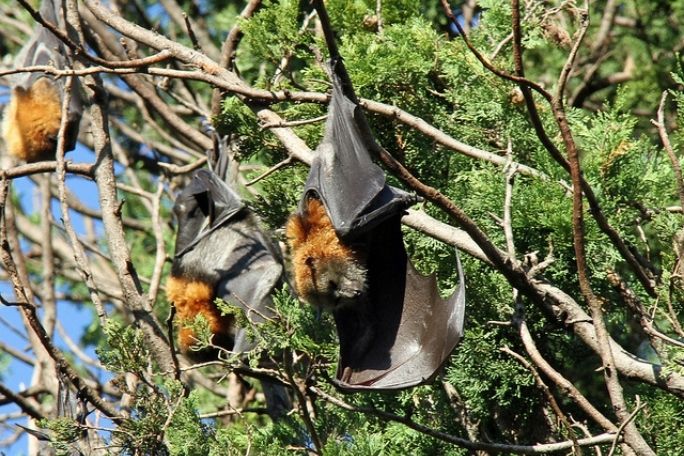Lesson summary
In this lesson, students compare environmental management strategies in Malaysia to those in Australia. Using the flying-fox as a case study, students will investigate how research becomes an important part of policymaking as well as how they can contribute to geographical and scientific data collection through citizen science. Students end the lesson by investigating how a local species contributes to the wider environment.
Learning intentions:
Students will...
- understand that native species provide ecosystem services for humans
- understand that geographical and scientific research influences land management and animal protection decisions
Success criteria:
Students can...
- recall at least one example of an ecosystem service provided by a native species
- cite an example of where research has influenced land management policy in Australia and overseas
- conduct rigorous research on a local native species and communicate this to an audience of their peers
Lesson guides and printables
Lesson details
Curriculum mapping
Australian curriculum content descriptions:
Year 9 Geography:
- Distribution and characteristics of biomes as regions with distinctive climates, soils, vegetation and productivity (ACHGK060).
- Human alteration of biomes to produce food, industrial materials and fibres, and the use of systems thinking to analyse the environmental effects of these alterations (ACHGK061).
- Challenges to food production, including land and water degradation, shortage of fresh water, competing land uses, and climate change, for Australia and other areas of the world (ACHGK063).
Year 9 Science:
- Multi-cellular organisms rely on coordinated and interdependent internal systems to respond to changes to their environment (ACSSU175).
- Ecosystems consist of communities of interdependent organisms and abiotic components of the environment; matter and energy flow through these systems (ACSSU176).
- People use scientific knowledge to evaluate whether they accept claims, explanations or predictions, and advances in science can affect people’s lives, including generating new career opportunities (ACSHE160).
- Values and needs of contemporary society can influence the focus of scientific research (ACSHE228).
Year 10 Geography:
- Select ONE of the following types of environment as the context for study: land (e.g. forests, deserts, grasslands, farmland), inland water, coast, marine or urban. A comparative study of examples selected from Australia and at least one other country should be included (ACHGK0082).
- The application of systems thinking to understanding the causes and likely consequences of the environmental change being investigated (ACHGK073).
- The application of geographical concepts and methods to the management of the environmental change being investigated (ACHGK074).
- The application of environmental economic and social criteria in evaluating management responses to the change (ACHGK075).
Year 10 Science:
- Values and needs of contemporary society can influence the focus of scientific research (ACSHE230).
- Critically analyse the validity of information in primary and secondary sources, and evaluate the approaches used to solve problems (ACSIS206).
Syllabus outcomes: GE5-1, GE5-2, GE5-3, GE5-4, GE5-5, SC5-11PW, SC5-13ES, SC5-14LW.
General capabilities: Information and CommunicationTechnology (ICT) Capability, Critical and Creative Thinking, Literacy.
Cross-curriculum priority: Sustainability OI.2.
Relevant parts of Year 9 Geography achievement standards: Students explain how geographical processes change the characteristics of places. They analyse interconnections between people, places and environments and explain how these interconnections influence people, and change places and environments. They predict changes in the characteristics of places over time and identify the possible implications of change for the future.
Relevant parts of Year 9 Science achievement standards: Students analyse how biological systems function and respond to external changes with reference to interdependencies, energy transfers and flows of matter. They describe social and technological factors that have influenced scientific developments and predict how future applications of science and technology may affect people’s lives.
Relevant parts of Year 10 Geography achievement standards: Students explain how interactions between geographical processes at different scales change the characteristics of places. Students identify, analyse and explain significant interconnections between people, places and environments and explain changes that result from these interconnections and their consequences.
Relevant parts of Year 10 Science achievement standards: Students explain the processes that underpin heredity and evolution.
Unit of work: ClimateWatch: Citizen Science – Geography – Years 9 & 10.
Time required: 90 mins.
Level of teacher scaffolding: Medium – the teacher will facilitate class discussions and group work.
Resources required
- Student Worksheets (one copy per student)
- Device capable of presenting a video to the class
- Enough internet-enabled devices to allow students to conduct paired research
Skills
- Communication
- Community engagement
- Creativity
- Critical thinking
- Digital literacy
- Social skills
Additional info
The lessons in this unit have been developed in partnership with Earthwatch.
Earthwatch developed the ClimateWatch program with the Bureau of Meteorology and The University of Melbourne to understand how changes in temperature and rainfall are affecting the seasonal behaviour of Australia’s plants and animals.


Welcome back!
Don't have an account yet?
Log in with:
By signing up to Cool.org you consent and agree to Cool's privacy policy to
store, manage and process your personal information. To read more, please see
our privacy policy here(Opens in new tab).
Create your free Cool.org account.
Many of our resources are free, with an option to upgrade to Cool+ for premium content.
Already have an account?
Sign up with:
By signing up to Cool.org you consent and agree to Cool's privacy policy to
store, manage and process your personal information. To read more, please see
our privacy policy here(Opens in new tab).